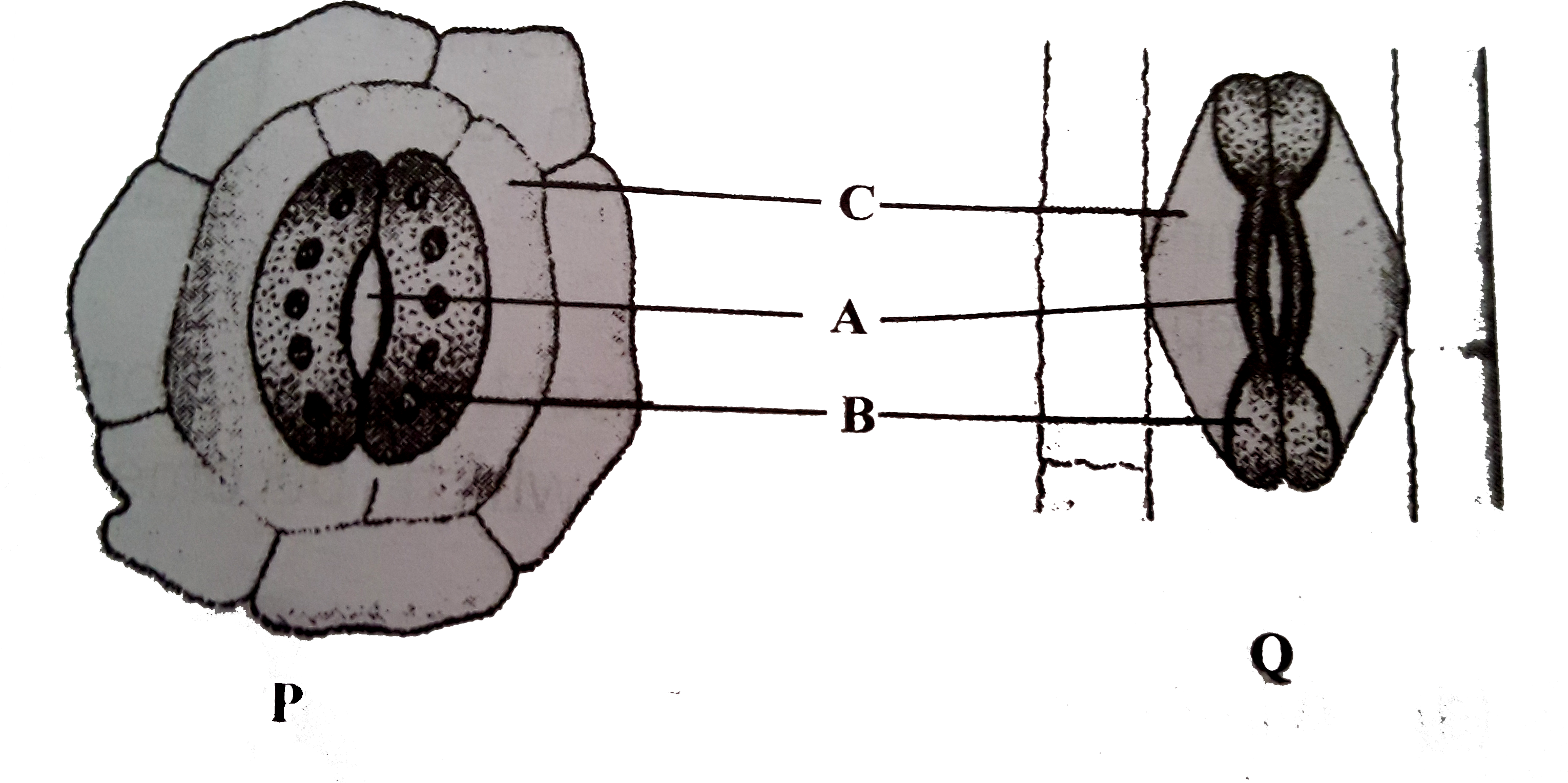(a) Palisade tissue is present towards upper epidermis in monocot leaves.
(b) Lower layer of mesophyll cells is loosely packed with few chloroplasts in dicot leaves.
( c) Dicot leaves have conjoint, collateral and closed vascular bundles.
All are incorrect
Only b is correct
Only a is incorrect
Only c is incorrect
The correct Answer is:C
To solve the question, we need to analyze each statement regarding the anatomy of monocot and dicot leaves:
1. Statement (a): Palisade tissue is present towards the upper epidermis in monocot leaves.
- Analysis: In monocot leaves, the mesophyll tissue is typically uniform and does not differentiate into palisade and spongy layers as seen in dicots. Therefore, the palisade tissue is absent in monocot leaves.
- Conclusion: This statement is incorrect.
2. Statement (b): Lower layer of mesophyll cells is loosely packed with few chloroplasts in dicot leaves.
- Analysis: In dicot leaves, the mesophyll is differentiated into palisade and spongy layers. The lower layer (spongy mesophyll) is indeed loosely packed and contains fewer chloroplasts compared to the upper palisade layer.
- Conclusion: This statement is correct.
3. Statement (c): Dicot leaves have conjoint, collateral, and closed vascular bundles.
- Analysis: In dicot leaves, vascular bundles are typically arranged in a conjoint manner (xylem and phloem are found together) and are collateral (xylem is located on one side and phloem on the other). Additionally, they are closed, meaning there is no cambium present between them.
- Conclusion: This statement is correct.
Final Evaluation:
- Statement (a) is incorrect.
- Statement (b) is correct.
- Statement (c) is correct.
Thus, the correct answer is that only statement (a) is incorrect.
- Analysis: In monocot leaves, the mesophyll tissue is typically uniform and does not differentiate into palisade and spongy layers as seen in dicots. Therefore, the palisade tissue is absent in monocot leaves.
- Conclusion: This statement is incorrect.
- Analysis: In dicot leaves, the mesophyll is differentiated into palisade and spongy layers. The lower layer (spongy mesophyll) is indeed loosely packed and contains fewer chloroplasts compared to the upper palisade layer.
- Conclusion: This statement is correct.
- Analysis: In dicot leaves, vascular bundles are typically arranged in a conjoint manner (xylem and phloem are found together) and are collateral (xylem is located on one side and phloem on the other). Additionally, they are closed, meaning there is no cambium present between them.
- Conclusion: This statement is correct.
- Statement (a) is incorrect.
- Statement (b) is correct.
- Statement (c) is correct.
Topper's Solved these Questions
- ANATOMY OF FLOWERING PLANTS BOOK - AAKASH INSTITUTE ENGLISHCHAPTER - ANATOMY OF FLOWERING PLANTS EXERCISE - ASSIGNMENT SECTION A (OBJECTIVE TYPE QUESTIONS)
52 Videos
- ANATOMY OF FLOWERING PLANTS BOOK - AAKASH INSTITUTE ENGLISHCHAPTER - ANATOMY OF FLOWERING PLANTS EXERCISE - ASSIGNMENT SECTION B Objective Type Questions
35 Videos
- ANATOMY OF FLOWERING PLANTS BOOK - AAKASH INSTITUTE ENGLISHCHAPTER - ANATOMY OF FLOWERING PLANTS EXERCISE - Try Yourself
38 Videos
- ANIMAL KINGDOM (CHORDATES) BOOK - AAKASH INSTITUTE ENGLISHCHAPTER - ANIMAL KINGDOM (CHORDATES) EXERCISE - Assignment (Section-D)
10 Videos
Similar Questions
Knowledge Check
Assertion: Vascular bundles are conjoint, collateral and closed in dicot stem
Reason: vascular bundles are conjoint,collateral and open in monocot stem.AIf both assertion and reason are true and reason is the correct explanantion of assertionBif both assertion and reason are true but reason is not the correct explanation of assertion.Cif assertion is true but reason is false.Dif both assertion and reason are false.
Given figures (P and Q) represent the stomatal apparatus of dicot and monocot leaves respectively. Select the option which correctly labels A, B and CAABCstomasubsidiary cellsguard cellsBABCstomasubsidiary cellsEpidermal cellsCABCGuard cellsstomaChloroplastDABCstomaGuard cellsSubsidiary cells
Consider the following statement:
A.The layer of bundle sheath cells in the leaves of C4 plants lacks intercellular spaces-
B. The bundle sheath cells in the leaves of C4 plants lack mitochondria and peroxisomes.-
C. The bundle sheath cells of C4 plants have large number of chloroplasts and thick walls.-
Neither C4 plants nor CAM plants have grana in their chloroplasts and thick walls. -
Which of the statements given above is/are correct?
View SolutionThe cross section of a plant material shows the following anatomical featrues under microscope:
(a) Sclerenchymatous bundle sheath
(b) Many vascular bundles are scattered in parenchymatous ground tissues, each vascular bundle is surrounded by sclerenchymatous bundle sheath.
(c) Vascular bundles are usually oval shaped.
(d) Vascular bundles are conjoint, collateral & closed and xylem is endarch
(e) Phloem parenchyma is absent and water containing cavities are present within the vascular bundles:
The plant material should be:
View SolutionConjoint and open vascular bundles are seen in
A) Dicot stem
B) Monocot stem
C) Dicot leaf
D)Monocot leaf
View SolutionRead the following statements about dicot stem and choose the correct option (a) Vascular bundles are arranged in a ring (b) Vascular bundles are conjoint, collateral and open type(C) Endarch type of arrangement of secondary xylem
View SolutionRead the following statements with respect to dicot stem and select the right choice .
i. The epidermis is covered with a thick layer of cuticle .
ii. The cells of endodermis are rich in starch grains.
iii. The pericycle is present on the inner side of endodermis and above the phloem in the of semilunar patches of sclerenchyma.
iv. The vascular bundles are arranged in a ring .
View SolutionRead the following statements.
A. All tissue on the inner side of the endodermis constitute the stele.
B. Peripheral vascular bundles are generally larger than the centrally located ones in monocot stems.
C. In late wood, cambium produces a large number of xylary elements having vessels with wider cavities.
D. The cork is impervious to water due to suberin deposition in the cell membrane.
How many of the above statements are incorrect?
View Solution
